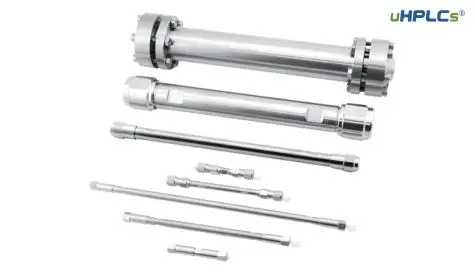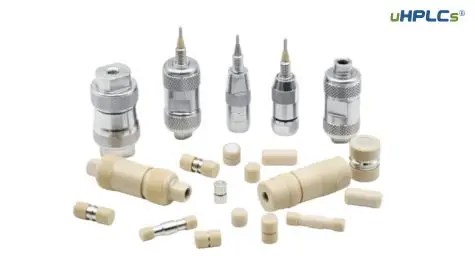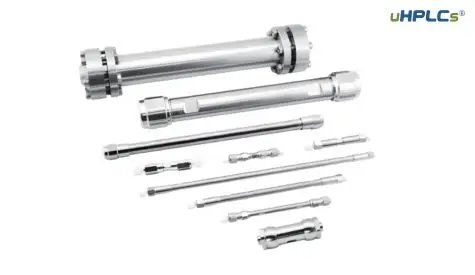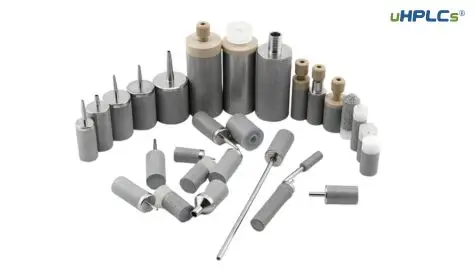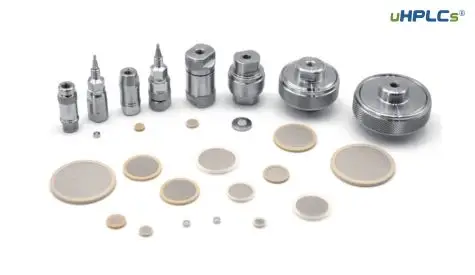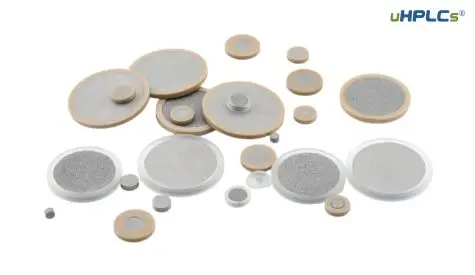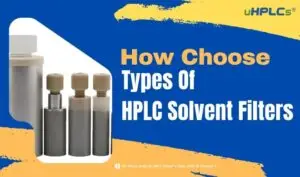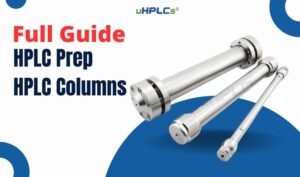Here we provides valuable insights and practical tips for developing analytical conditions in high-performance liquid chromatography (HPLC). Hope This will let you know details of Analysis Of Condition Filtering Methods and help you to find the right filter method for your project.
1. Understanding the target compound and impurities:
Analyzing the properties of the target compound and impurities is crucial in the first step of developing analytical conditions for HPLC. Here’s why:
Molecular weight:
- Larger molecules generally interact more strongly with the stationary phase, leading to longer retention times. Predicting the size of the target and impurities helps choose a column with appropriate pore size and surface area.
Structural formula:
- Functional groups like -OH, -NH2, and -COOH influence polarity and hydrogen bonding capabilities. This information helps predict retention behavior on different column types (normal phase, reversed phase, etc.) and select suitable elution solvents.
Solvent tolerance:
- Some compounds might degrade or precipitate in certain solvents. Knowing the solvent compatibility of the target and impurities ensures they remain stable throughout the analysis.
By understanding these properties, you can:
- Predict polarity: Polar compounds interact more with polar stationary phases and vice versa. Knowing the polarity of your target and impurities helps choose the right column and elution solvents.
- Estimate retention: Larger and more polar molecules tend to be retained longer on the column. Predicting retention times aids in optimizing gradient elution programs and setting detection times.
- Select suitable elution solvents: Choose solvents that effectively elute the target compound and impurities without causing unwanted interactions or precipitation.
Remember, this is just the first step. Combining this information with other factors like column type, flow rate, and temperature will ultimately lead to successful HPLC method development.
Do you have any specific target compounds or impurities in mind that you’d like to discuss further? I’m happy to help you analyze their properties and predict their chromatographic behavior!
2. Determining elution mode:
Starting with 60% acetonitrile/methanol: This is a good starting point for reversed-phase separations due to their strong elution power and relatively good solubility for various analytes. It’s often effective for simple mixtures where baseline resolution is adequate.
Adjusting the organic phase ratio: This is the key to fine-tuning elution profiles. Increasing the organic phase concentration elutes components faster, while decreasing it lengthens their retention times. Monitor peak separation and elution time to optimize the ratio for good resolution and acceptable analysis time.
Methanol-water vs. Acetonitrile-water: Both offer advantages and disadvantages:
- Elution capacity: Acetonitrile generally elutes compounds faster than methanol at the same concentration. This can be beneficial for quicker analyses or resolving closely eluting peaks.
- Thermal effects: Methanol dissolves in water with an exothermic reaction, while acetonitrile is endothermic. This can affect your baseline stability, with methanol potentially causing more baseline fluctuations.
- Cost: Methanol is usually cheaper than acetonitrile, which might be a factor for high-volume analyses.
- Cut-off absorption wavelength: Methanol absorbs UV light around 210 nm, while acetonitrile absorbs around 190 nm. If your detection wavelength is near 210 nm, acetonitrile might be preferred to avoid interference from the mobile phase.
Ultimately, the best system depends on your specific needs and priorities. Experimenting with both can help you find the optimal choice for your analysis.
Additional tips:
- Consider using mixed buffer systems, which can enhance peak shapes and baseline stability.
- Evaluate gradient elution if isocratic conditions struggle to separate your target and impurities.
- Always consult safety data sheets and handle solvents with caution.
I hope this clarifies the considerations when determining the elution mode! Feel free to ask if you have any further questions or specific scenarios you’d like to discuss.
3. Choosing column, flow rate, and temperature:
These are crucial aspects of optimizing your HPLC separation. Here’s a breakdown of each point with some additional insights:
Choosing the column:
- 5μm 4.6×250mm columns are common: This is a good starting point for many analyses due to their balance of efficiency, capacity, and pressure. However, consider adjusting based on your needs:
- Sample complexity: For complex mixtures with many closely eluting peaks, smaller particle sizes (3μm or even 2μm) can provide better resolution but require higher pressure and slower flow rates.
- Separation efficiency: If high resolution is your priority, consider columns with narrower pore sizes or longer lengths.
- Stationary phase: Choose the appropriate phase (C18, C8, etc.) based on the polarity of your target compound and impurities.
Flow rate:
- 1.0 mL/min is a common starting point: Adjust based on the specific column and its maximum pressure rating. Higher flow rates shorten analysis time but can decrease resolution and increase peak broadening. Lower flow rates improve resolution but take longer.
- Consider the viscosity of your mobile phase: More viscous solvents require lower flow rates to maintain optimal pressure.
Temperature:
- 25-35°C is a recommended range: Higher temperatures can accelerate analysis but also lead to faster column degradation and potential peak broadening.
- Some specific compounds might require higher temperatures: Consult literature or technical recommendations for your specific case.
Additional tips:
- Pre-column filters can protect your analytical column from sample particulates.
- Regular flushing and equilibration of the column ensure optimal performance.
- Consider using column guards to prolong the life of your analytical column.
Remember, choosing the optimal combination of column, flow rate, and temperature depends on your specific analysis goals and sample characteristics. Experimenting within recommended ranges and consulting technical resources can help you find the sweet spot for successful HPLC separations.
4. Gradient elution program selection:
Gradient elution can be a powerful tool when isocratic elution falls short. Here’s a deeper dive into your points:
When to use gradient elution:
- As you mentioned, when separation with a single mobile phase (isocratic elution) proves insufficient for resolving peaks of interest, especially for complex mixtures with a wide range of retention times.
- Gradient elution allows for tailoring the elution strength over time, enabling separation of closely eluting peaks that wouldn’t be possible with an isocratic setup.
Gradually increasing organic phase concentration:
- This is the core principle of gradient elution. By starting with a lower organic phase concentration and gradually increasing it, you elute compounds with varying affinities for the stationary phase at different times.
- The rate of increase, known as the gradient slope, influences resolution and analysis time. Steeper slopes can separate faster but might compromise resolution, while shallower slopes provide better separation but take longer.
Avoiding pure mobile phases:
- Using a pure mobile phase as the initial and final mobile phase (e.g., starting with pure buffer and transitioning to pure organic solvent) can cause significant baseline fluctuations and ghost peaks due to mixing different polarities.
- Using mixed phases with buffer salts and organic solvents in both the initial and final compositions helps minimize these issues.
- The buffer salts also maintain consistent pH throughout the gradient, further enhancing stability and peak shapes.
Additional tips for gradient elution:
- Experiment with different gradient shapes (linear, convex, concave) to optimize separation for your specific sample.
- Consider using hold times at specific organic phase concentrations to improve resolution for critical peaks.
- Monitor baseline stability and ghost peaks throughout gradient optimization.
- Consult HPLC instrument manuals and technical resources for specific gradient programming options and limitations.
So choosing the optimal gradient elution program requires careful consideration of your sample characteristics, desired resolution, and analysis time constraints. With a bit of experimentation and understanding of the underlying principles, you can unlock the full potential of gradient elution for your HPLC analyses.
5. Choosing buffer salts:
Choosing the right buffer salts is crucial for optimizing your HPLC analysis. Let’s explore this further:
Roles of buffer salts:
- Adjusting mobile phase pH: Buffer salts maintain a stable pH throughout the run, preventing unwanted changes in elution behavior due to pH fluctuations. This is important for consistent retention times and peak shapes.
- Enhancing retention: Certain buffer salts can interact with specific functional groups on analytes, such as amino groups and carboxylic acids, increasing their retention on the stationary phase. This can be helpful for improving resolution, especially for closely eluting peaks.
Common buffer salts:
- Potassium dihydrogen phosphate (KH2PO4): Commonly used for acidic mobile phases (pH 2-5). It provides good buffering capacity and minimal ion-pairing effects.
- Ammonium acetate (CH3COONH4): Suitable for neutral to slightly basic mobile phases (pH 5-8). It offers good solubility and minimal UV absorption, making it ideal for UV detection.
Phosphate for preventing hydrolysis:
- Components with hydroxyl (-OH) groups are susceptible to hydrolysis under neutral or basic conditions, leading to peak broadening and ghost peaks.
- Adding phosphoric acid or phosphate salts can adjust the pH to acidic conditions (pH 2-3), effectively suppressing hydrolysis and maintaining peak integrity.
Additional considerations:
- Buffering capacity: Choose salts with appropriate buffering capacity based on the desired pH range and stability requirements.
- Ionic strength: High ionic strength from buffer salts can affect retention and peak shapes. Optimize the concentration to achieve adequate buffering without compromising separation.
- Compatibility with mobile phase components: Ensure the chosen buffer salts are compatible with the organic solvents and other additives used in your mobile phase.
Choosing the optimal buffer salt often involves experimentation and fine-tuning. Consulting technical resources and HPLC literature for specific recommendations based on your sample and separation goals can be very helpful.
6. Selecting detection wavelength:
Selecting the optimal detection wavelength is crucial for maximizing sensitivity and specificity in your HPLC analysis. Here’s a deeper dive into your points:
Choosing the wavelength of maximum absorption:
- This is the golden rule! Analytes absorb specific wavelengths of UV light based on their chemical structure. Detecting at the wavelength where your target compound and impurities exhibit maximum absorption will provide the highest signal-to-noise ratio and improve sensitivity.
- You can determine the maximum absorption wavelengths by analyzing the UV spectra of your target compound and impurities or consulting available literature.
Avoiding the 190-210 nm range:
- While this range offers higher sensitivity due to lower baseline noise, it’s often riddled with interferences from mobile phase impurities and solvents. Using wavelengths above 210 nm minimizes these interferences and ensures reliable detection of your analytes.
Secondary wavelengths:
- Using multiple wavelengths can provide additional information about your sample. This is particularly beneficial when:
- You have overlapping peaks and need to differentiate them based on their spectral fingerprint.
- You want to monitor impurities that absorb at different wavelengths than your target compound.
- You perform qualitative analysis for compound identification beyond simply confirming presence.
Additional considerations:
- Detector compatibility: Your HPLC instrument might have limitations on the detectable wavelength range. Ensure your chosen wavelength falls within your instrument’s capabilities.
- Lamp lifetime: Some lamps used in UV detectors have specific emission peaks. Choose a wavelength that coincides with the peak emission of your lamp for optimal sensitivity.
- Solvent and buffer selection: Consider the UV cut-off of your mobile phase solvents and buffer salts. Avoid wavelengths below the cut-off, as the solvent itself will absorb and significantly reduce sensitivity.
Selecting the optimal detection wavelength is an iterative process. It often involves analyzing UV spectra, experimenting with different wavelengths, and evaluating the resulting chromatograms. Consulting technical resources and HPLC manuals can provide valuable guidance for specific instruments and applications.
7. Choosing solvent:
As following are key considerations for solvent choice in HPLC, Let’s make a deeper dive into each point:
1. Solvent for Isocratic Elution:
- Using the mobile phase itself: This is the standard practice for isocratic elution. Since the mobile phase composition remains constant throughout the run, using it as the solvent ensures consistency and avoids any sudden changes in elution strength.
2. Solvent for Gradient Elution:
- Matching initial gradient concentration: This is crucial to minimize disruptions in peak shape and retention time. A solvent with a similar organic phase concentration to the initial gradient ensures a smooth transition and maintains the established equilibrium between the stationary phase and analytes.
3. Solvent Solubility and Peak Separation:
- Complete sample dissolution: The solvent must fully dissolve the sample to ensure accurate and consistent injection. Incomplete dissolution can lead to precipitation and inaccurate results.
- No interference with separation: The solvent shouldn’t significantly affect the retention of target compounds or impurities. Choose a solvent that maintains the desired separation and peak resolution.
Additional Considerations:
- Solvent purity: High-purity solvents are essential to minimize baseline noise and interferences, especially for UV detection.
- Viscosity: Solvent viscosity affects column pressure and flow rate. Choose solvents with appropriate viscosity for your system’s capabilities.
- Compatibility: Ensure compatibility with the stationary phase, mobile phase components, and detector.
More Tips
- Experimentation is often necessary to find the optimal solvent for your specific sample and HPLC setup.
- Consult technical resources and literature for recommendations based on your analysis goals.
- Proper solvent handling and safety practices are crucial in the lab.
Feel free to ask if you have any further questions about choosing solvents for different HPLC applications or troubleshooting solvent-related issues!



